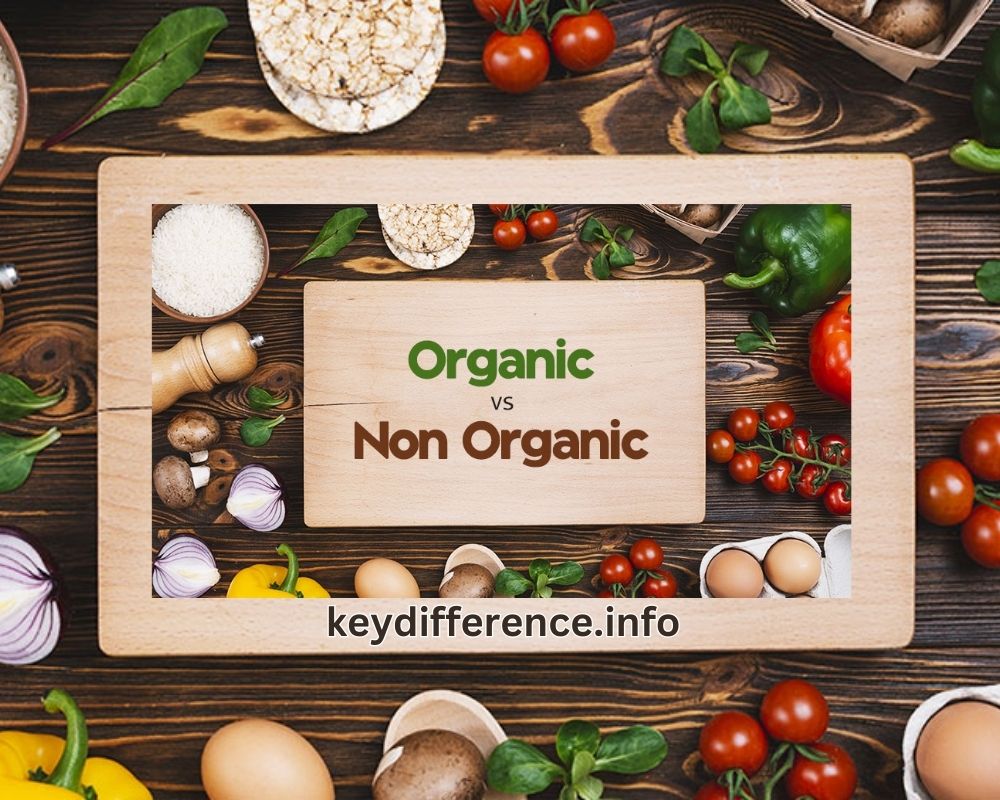Introduction to Organic and Non Organic Food
Organic and Non Organic Food are two categories that differentiate farming practices and the quality of food produced. Many people do not know that Organic food is produced without the use of artificial chemicals, pesticides, and genetically modified organisms. It emphasizes natural methods like crop rotation and biological pest control. Organic farming follows strict certification standards to ensure compliance.
On the other hand, non-organic food is conventionally produced, utilizing synthetic chemicals and GMOs to maximize yields. While non-organic food meets safety regulations, concerns exist regarding potential health risks and environmental impacts. Making choices between the two depends on individual preferences, health considerations, and availability. Both types can contribute to a balanced diet, but organic food is sought after for its perceived health benefits and environmentally-friendly practices.
Growing consumer interest in organic food
In recent years, It is clear that increasing for consumer interest in organic foods.
This increased demand is due to several factors:
Health and Wellness
- Folks have learned more about their health and how they should take care of themselves. People look to organic food as a healthier option because it is free of GMOs and synthetic pesticides. Organic food is perceived to have higher nutritional content and fewer potentially harmful substances. This aligns with the desire of many for a natural, wholesome diet.
Environmental Awareness
- Organic food is increasing in popularity due to customers being more aware of the effects of traditional farming on the environment. Organic farming practices prioritize sustainability, soil and water conservation, biodiversity, and biodiversity. Consumers who are conscious of the environment wish to support farming methods that do not put a strain on the environment, and this is in line with those beliefs.
Food Safety Issues
- Reports of contamination and high-profile recalls have caused worries about food safety. Organic food is seen by some consumers as a healthier option because it has to adhere to stricter organic standards and undergoes certification.
Ethical considerations
- Animal welfare and the fair treatment of farmworkers are becoming increasingly important to consumers. Organic farming involves humane practices such as allowing animals to roam freely and graze in the open air, and following stricter guidelines regarding animal care. Consumers who place a high priority on ethical issues in their buying decisions will be attracted to this aspect.
Accessibility and Availability
- Organic foods have become much more widely available in recent years. Organic products can be found more easily in regular supermarkets, health food specialty stores, and the internet. The increased availability of organic products makes it easier for customers to select them.
The Influence of Social Media on Information Sharing
- Organic food awareness has grown significantly as a result of social media and information-sharing platforms. The consumer now has access to a wealth of information including scientific studies and personal testimonials. This helps educate and inform consumers about the benefits of organic food.
All purchasers become captivated in organic foods and It can be said that organic food markets have increased the demand of skyrocket for organic products.
What is Organic Food?
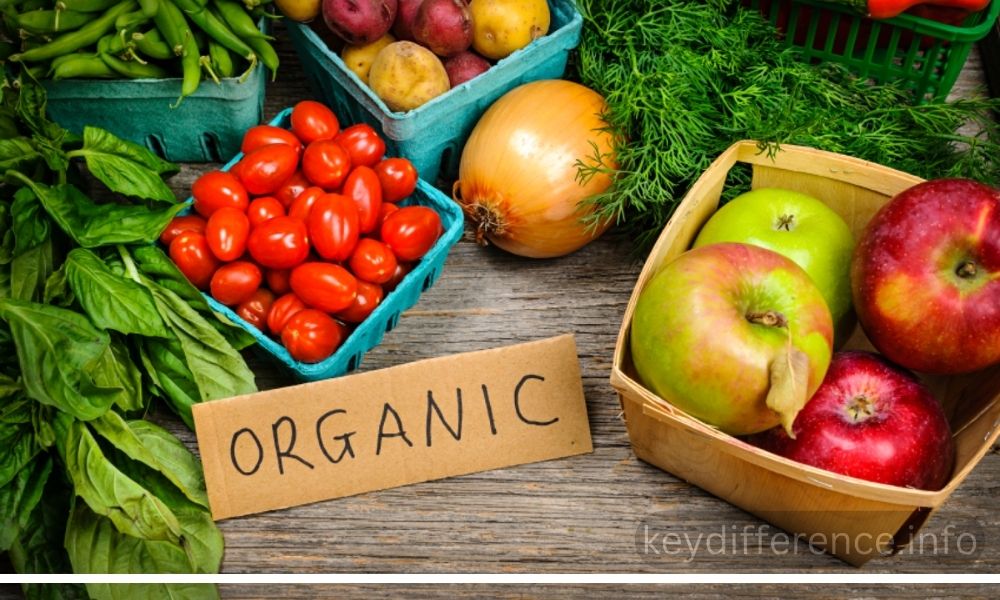
Organic food refers to any product produced through ecological farming methods emphasizing sustainability and natural practices while limiting synthetic chemicals or GMOs (Genetically Modified Organisms).
Organic farming emphasizes ecological balance, biodiversity conservation, and soil and water quality enhancement. Instead of synthetic pesticides and fertilizers being employed for this endeavor, natural alternatives such as crop rotation, composting, and biological pest control solutions such as biological control are used instead. Organic food typically does not contain GMOs as its production does not use genetic engineering or modification of organisms.
In contrast, organic livestock farming places particular attention on animal welfare by offering animals better living conditions while restricting growth hormone use and antibiotic prescribing practices. Many countries have instituted certification programs in order to guarantee organic standards are upheld, such as environmental concerns or support of sustainable agriculture. While organic foods may be chosen due to individual preferences or beliefs, adherence to organic standards does depend on certification programs being in place in each country.
Organic Farming Methods
- Diverse techniques are used in organic farming with an emphasis on ecological sustainability, biodiversity, and the use of natural inputs. These practices promote soil health, reduce the use of synthetic chemicals and seek to establish an ecologically balanced ecosystem in the field. Here are the most important organic farming techniques:
Elimination of synthetic Pesticides along with Fertilizers
- Synthetic fertilizers, insecticides, and herbicides are not used in organic farming. Instead, organic alternatives are employed to combat weeds and pests and improve soil fertility. This is done through the use of bio-based pest control techniques like helpful insects, the trapping of crops in addition to the use of predators to control pests efficiently. Organic farmers also depend in crop rotation. It is cultivating different crops in order to interrupt disease and pest cycles and increase soil health.
Utilization of Natural Fertilizers and Soil Management
- Organic farming focuses on the use of natural fertilizers such as compost, animal manure or green manure (cover crops that are cultivated and then plowed through the soil). Organic materials are essential nutrients to plants and increase soil structure and water retention and nutrient cycle. Methods of soil management such as mulching, crop rotation and the correct tillage practices keep soil health in check, stop erosion, and increase the activity of microbial organisms.
Conservation of Soil and Water
- Diverse techniques are used by organic farms to safeguard the land and water supply. They can reduce the erosion of soil by using methods like road terracing, contour plowing and maintaining a vegetation cover. Conservation methods for water like drip irrigation and rainwater harvesting are frequently employed to maximize water use and reduce waste.
Promotion of Biodiversity
- By establishing ecosystems that are advantageous to wildlife, including birds, insects, and other creatures, organic farming encourages biodiversity. By maintaining hedgerows and providing nesting spots, and conserving natural areas in and around their farms, organic growers help maintain the balance of nature and create an ecosystem that is diverse and resilient. Biodiversity can help control pests naturally as well as improves pollination levels and boosts the overall productivity of farms.
Livestock Management
- Organic livestock management is the process of giving animals access to outdoor and pasture areas, providing enough room for movement, as well as providing them with organic food. Utilization of antibiotics is limited and preventive measures like vaccination and hygiene practices are stressed.
Livestock waste is handled in a sustainable and environmentally friendly manner usually with composting or manure-management methods that limit the emission of pollutants in the surrounding environment. Organic farming practices emphasize long-term sustainability, environmental management, and the wise use of natural resources. When they adopt these methods organic farmers seek to create nutritious, premium food, with minimal negative impact of the environmental, promoting the welfare of animals, and making a stronger and more sustainable food system.
Benefits of Organic Food
There are various advantages to eating organic food for both consumers and the environment.
The following are key advantages associated with consuming organic food:
Reduced Exposure to Chemical Residues
- Synthetic pesticides, herbicides, and fertilizers are not allowed in organic farming since they can leave residues on conventional food. Choosing organic food helps reduce exposure to potentially harmful chemicals, minimizing the risks associated with pesticide residues in the diet.
Higher Nutritional Value
- Synthetic pesticides, herbicides, and fertilizers—which may leave traces on conventional produce—are not allowed in organic farming. Additionally, antibiotics and growth hormones are often not given to organic cattle fed on organic feed, resulting in meat and dairy products devoid of harmful chemicals.
Improved Environmental Sustainability
- Organic farming practices prioritize soil health, water conservation, and biodiversity. By avoiding synthetic inputs and adopting sustainable techniques, organic farming promotes the preservation of soil fertility, reduces soil erosion, conserves water resources, and supports the overall ecological balance. By establishing ecosystems and using less toxic pesticides, organic farms also help to safeguard pollinators, beneficial insects, and animals.
Enhanced Flavor and Quality
- Many people believe that organic produce tastes better than produce cultivated in a traditional manner. Organic farming methods, with their focus on soil health and natural inputs, can contribute to the development of flavorsome and high-quality crops. Organic livestock raised in more natural conditions may also offer improved taste and texture in meat and dairy products.
Support for Sustainable Agriculture
- By choosing organic food, consumers support farmers who adopt sustainable and environmentally friendly practices. Organic farming methods prioritize long-term soil fertility, biodiversity conservation, and responsible resource management. Supporting organic farming encourages the growth of resilient and regenerative farming systems that put the wellbeing of communities and the environment first.
Reduced Antibiotic Resistance
- Organic livestock production prohibits the routine use of antibiotics as growth promoters or for disease prevention. This method reduces the growth of germs that are resistant to antibiotics, which is a major worry in traditional cattle husbandry.
Customers may support the broader fight against antibiotic resistance and the ethical use of antibiotics in animal agriculture by eating organic meat and dairy products.
It is important to note that while organic food offers various benefits, individual food choices should also consider personal preferences, availability, and affordability. In the end, selecting organic food promotes a more ecologically friendly and sustainable method of farming and food production.
Organic Food Labeling and Certifications
Labeling and certification of organic foods are crucial in providing consumers with transparency and assurance about authenticity and integrity. The certification programs make sure that organic products meet certain standards and adhere to organic farming practices. Here are some of the key aspects to organic food certification and labeling:
Organic Certification Programs
- To regulate organic food production and labeling, many countries and regions established certification programs. These programs usually involve a rigorous, third-party certification process. The certification process involves on-site inspections and documentation reviews, as well as testing to verify compliance.
Organic Labels
- Labels and seals indicating the organic status of products are used to identify them. The labels can vary based on the certification program, the country or the region. In the United States and Europe, organic labels such as “USDA Organic”, “EU Organic”, “JAS Organic”, etc. are common. These labels ensure that consumers are buying products that have been produced in accordance with organic standards.
Labeling requirements
- The organic food label usually includes information on the organic certification agency and its seal or logo. Additionally, it displays the proportion of organic materials in the final product. A product’s label frequently states whether it is “100% Organic,” “Organic” (contains at least 95% organic components), or “Made with Organic Ingredients” (contains 80% organic materials). For organic items, some labels state the country of manufacture.
Compliance Monitoring
- The method for certifying organic products includes continuing compliance and oversight measures to make sure certified farmers regularly uphold the organic criteria. Regular inspections and audits are conducted to guarantee that organic agricultural procedures, such as the usage of organic inputs, are followed. Penalties or the loss of organic certification are possible outcomes of non-compliance.
International Equivalency Agreements
- Some countries have created international equivalency agreements for organic products to facilitate trade and increase consumer confidence. These agreements acknowledge the organic certification processes and standards of partner countries. They allow organic products certified in one country to be sold in another as organic with labeling requirements that are mutually agreed upon. These agreements encourage harmonization and consistency within the organic food trade.
When consumers look for organic certifications and labels, they can make informed decisions and be confident that the products purchased meet organic standards.
Organic food certification and labeling provide consumers with the confidence that organic products are authentic and true. This encourages a tighter interaction between organic farmers and customers who desire nutritious and sustainable food, as well as openness in the organic market.
What is Non-Organic Food?
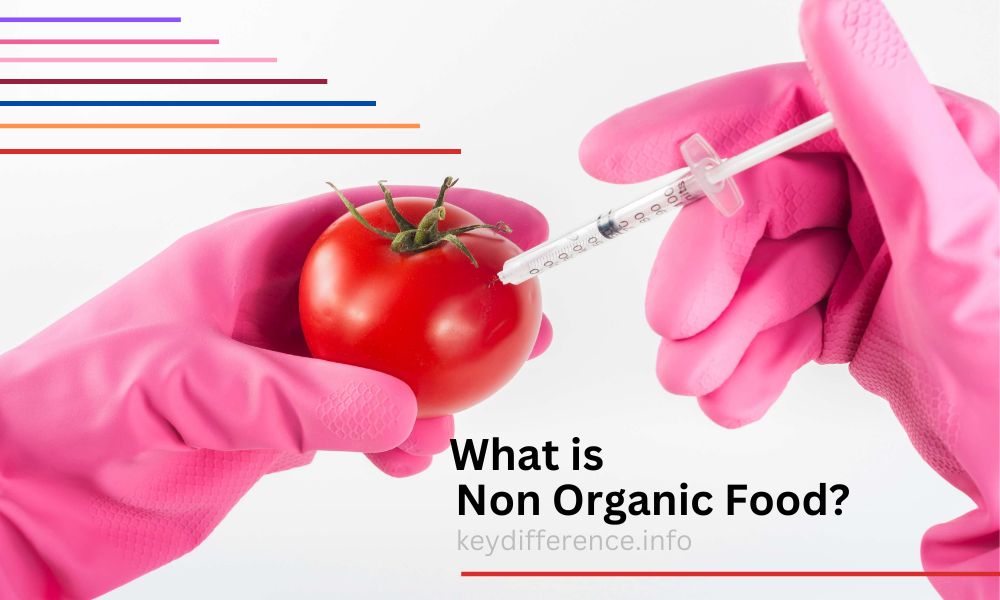
Non-organic food is defined as food that is produced using farming practices that are not organic, such as employing synthetic chemicals like pesticides, herbicides, and fertilizers.
Non-organic farming prioritizes increasing crop yields and use synthetic chemicals to manage pests and illnesses. Utilizing genetically modified organisms (GMOs) may potentially be a part of it. Food that is not organic is readily accessible and frequently more inexpensive. Concerns do arise, nevertheless, regarding possible health dangers linked to consuming GMOs and synthetic chemicals found in non-organic food.
Conventional Farming Methods
- The predominant strategy for producing food in the world is conventional farming, sometimes known as industrial agriculture or conventional farming. These techniques are described as intense production and inputs that are synthetic. Here are a few essential characteristics of traditional farming:
Artificial Inputs
- In traditional agriculture, synthetic insecticides, herbicides, and fertilizers are employed. Synthetic fertilizers are frequently concentrated and give plants vital nutrients. In order to increase agricultural yields, synthetic pesticides and herbicides are used to control weeds, illnesses, and pests. Typically, industrial procedures are used to create these inputs.
Monocultures
- Monocultures are a common practice in conventional farming, where large plots of land are devoted to a single species. Monocultures simplify management and harvesting and streamline production. Monocultures can reduce biodiversity, and increase vulnerability to pests, diseases, and soil degradation.
Genetic Modification
- Traditionally practiced agriculture employs genetically modified organisms. Genetic modification is the intentional altering of an organism’s genetic makeup to impart features like resistance to disease, pests, or herbicides. GMO crops, such as cotton, corn, and soybeans, are frequently grown using traditional farming practices.
Resource Intensive Use
- In conventional farming, high productivity and yields are often the main priorities. This can involve heavy use of land, water, and energy resources. The use of irrigation systems, machinery and synthetic inputs can increase resource consumption and impact the environment.
Livestock Production
- Animals are often grown in CAFOs (concentrated animal feeding facilities) in conventional livestock production. These systems are made to be as efficient and inexpensive as possible. Animals at CAFOs are frequently raised in cramped conditions and given a diet mostly composed of conventional feed. This can include genetically modified crops or synthetic additives.
Technological interventions
- To increase productivity, conventional farming uses a variety of technological interventions. It includes the use of advanced machinery and equipment to plant, harvest, and process crops. Precision agriculture, digital farming tools and other modern technologies are often used in conventional agriculture to monitor crop performance and optimize inputs.
Conventional farming methods are able to meet the large-scale demand for food. They have raised concerns about environmental sustainability, soil quality, biodiversity loss and chemical residues. These concerns led to the promotion and development of alternative approaches such as organic agriculture, which prioritize sustainable practices while reducing reliance on synthetic chemicals.
Potential Risks and Concerns of Non-Organic Food
Consuming non-organic food has a number of possible dangers including sustainability, environmental impact, and human health problems.
Here are some key issues associated with non-organic food:
Pesticide Residues
- Synthetic pesticides are used in non-organic farming to manage illnesses and pests. Residues of these chemical substances can remain on crops and may be ingested by consumers.
Antibiotic Resistance
- In non-organic animal agriculture, antibiotics are often used as growth promoters or for disease prevention in intensive farming systems. Antibiotic resistance may spread if non-organic meat and dairy products made from animals given antibiotics are consumed.
GMOs and Genetic Engineering
- The production of genetically modified organisms (GMOs) may take place in non-organic farming. Crops can be given certain qualities, such as resistance to pests, diseases, or herbicides, using genetic engineering techniques. GMOs are a source of worry because to potential long-term implications on human health, environmental damage, and biodiversity preservation.
Environmental Impact
- Agriculture that is not organic can harm the environment. Synthetic pesticides and fertilizers can destroy beneficial insects, birds, and aquatic life by contaminating soil, rivers, and ecosystems.
Traditional agricultural methods may be responsible for soil erosion, soil fertility loss, and biodiversity damage. The intensive resource use associated with non-organic farming, such as water consumption and energy requirements, can also contribute to environmental strain.
Lack of Nutritional Quality
- Compared to organic food, non-organic food may be of lesser nutritional grade. Studies have shown that the lack of synthetic fertilizers and the focus on soil health typically results in organic crops having greater amounts of certain nutrients, such as vitamins, minerals, and antioxidants. Non-organic livestock products may also differ in nutritional composition, particularly regarding fat quality and potential residue content from feed additives.
Animal Welfare
- Non-organic animal agriculture, particularly in intensive confinement systems, can raise concerns about animal welfare. Animals may be subjected to crowded and stressful conditions, limited access to outdoor areas, and practices that prioritize high production yields over animal well-being. Additionally, the use of hormones and antibiotics that promote growth in the production of non-organic livestock might have an effect on the health and wellbeing of the animals.
In order to assure food safety and compliance with allowable levels of chemical residues, regulatory agencies and organizations develop rules and guidelines for the manufacturing of non-organic foods. The possible dangers and issues with non-organic food have fueled a rise in the demand for organic substitutes and raised consumer awareness of the need of making healthy and sustainable food choices.
Differences Between Organic and Non Organic Food
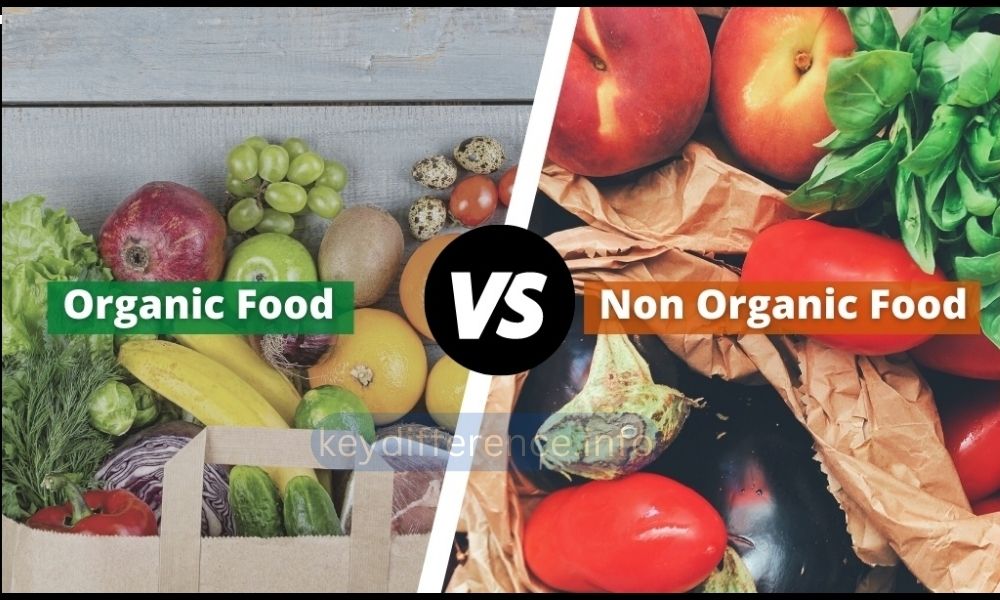
Between organic and conventional food, there are a number of significant distinctions. These discrepancies can be due to different agricultural practices, the use of synthetic chemicals, their influence on the environment, their nutrient content, and considerations for animal welfare.
Here are the key distinctions:
Production Methods
Organic and non-organic food production methods differ significantly. Organic farming focuses on sustainable practices, such as soil enrichment, natural pest control, and the exclusion of GMOs. Livestock is raised with emphasis on welfare and access to pasture.
Contrarily, conventional farming uses synthetic inputs like pesticides, fertilizers, and GMOs, as well as intensive techniques, the usage of antibiotics, and hormones.
These differences reflect distinct approaches to agriculture, with organic farming prioritizing environmental stewardship and natural inputs, while non-organic farming emphasizes high yields and efficiency. Consumers can make choices based on their preferences for sustainable and natural farming or conventional practices.
Use of Synthetic Chemicals
One of the main differences between the manufacturing of organic and non-organic food is the usage of synthetic chemicals. The use of synthetic chemicals, such as synthetic fertilizers, insecticides, and herbicides, is tightly limited or avoided in organic farming.
Instead, organic farmers focus on natural alternatives, such as compost, animal manure, and biological pest control methods. With this strategy, the potential for harm to the environment and human health is decreased while also promoting the health of the soil and ecosystems and reducing chemical residues in food.
In contrast, non-organic farming relies heavily on synthetic chemicals to maximize crop yields, control pests and diseases, and manage weeds.
The use of synthetic pesticides in non-organic farming raises worries about potential environmental contamination, the emergence of pesticide resistance, and the presence of chemical residues in food, even if it is regulated to satisfy safety requirements. Choosing organic food provides consumers with an option to minimize their exposure to synthetic chemicals and support environmentally-friendly agricultural practices.
Impact on the Environment
When contrasting the production of organic and non-organic foods, the effect on the environment must be taken into account. Organic farming practices prioritize environmental sustainability by promoting soil health, biodiversity, and conservation.
Organic farmers employ techniques like crop rotation, composting, and natural pest control methods, reducing the reliance on synthetic inputs and minimizing soil erosion, water pollution, and habitat destruction. Additionally, organic farming promotes carbon sequestration and the conservation of natural resources like water and energy.
Contrarily, non-organic farming frequently uses monocultures, intensive techniques, and synthetic chemicals, which can cause soil degradation, water pollution, and biodiversity loss. As a result of the energy-intensive manufacture of synthetic fertilizers and the transportation of inputs, non-organic farming may also have a bigger carbon footprint. Opting for organic food supports farming methods that have a lower environmental impact and prioritize the long-term health of ecosystems.
Nutrient Content and Quality
When comparing organic and non-organic food, the nutrient content and overall quality can vary. Organic food is frequently praised for its potential to have higher concentrations of particular nutrients. Organic farming methods, such putting soil health first and utilizing natural fertilizers, may boost the availability of nutrients in the soil, which might lead to better nutritional content in organic crops.
Certain research imply that various antioxidants and beneficial chemicals may be present in higher concentrations in organic food.
Other elements that are not completely dependent on organic or non-organic production techniques, such as crop variety, soil quality, and post-harvest management, can also have an impact on the total nutrient content.
It is vital to remember that both organic and non-organic foods may be included in a healthy diet, and that nutrient intake and overall food quality are significantly influenced by elements including freshness, diversity, and dietary habits.
Animal Welfare Considerations
Animal welfare considerations differ between organic and non-organic food production. Organic farming standards prioritize animal welfare by providing animals with access to outdoor spaces and pasture, allowing them to engage in natural behaviors.
Organic livestock must be raised on organic feed that is free from genetically modified ingredients and synthetic additives. Antibiotic use in organic livestock is restricted, and hormones for growth promotion are prohibited.
Contrarily, non-organic farming methods may include confined or intensive systems, such as concentrated animal feeding operations (CAFOs), which might generate issues with regard to animal welfare due to their constrained living quarters and unfavorable living circumstances.
Non-organic livestock may receive antibiotics for disease prevention or growth promotion, and hormones may be used to enhance productivity. Choosing organic food supports a farming system that places greater emphasis on animal welfare, allowing animals to live in more natural and humane conditions.
These differences help consumers make informed choices based on their preferences, health concerns, environmental values, and animal welfare considerations. It’s vital to remember that both organic and non-organic food may satisfy a variety of customer demands and tastes while still contributing to the total food supply.
Comparison Table: Organic and Non-Organic Food
Here’s a comparison table highlighting some key differences between organic and non-organic food:
| Aspect | Organic Food | Non-Organic Food |
|---|---|---|
| Production Methods | Emphasizes natural and sustainable farming practices, such as crop rotation, composting, and biological pest control. | It uses artificial fertilizers, herbicides and genetically modified organisms (GMOs) in traditional farming techniques. |
| Chemical Use | Limits or avoids synthetic chemicals, pesticides, and synthetic fertilizers. | uses artificial fertilizers, insecticides, and chemicals to promote crop growth and manage pests and illnesses. |
| GMOs | Prohibits the use of genetically modified organisms (GMOs). | May involve the cultivation of genetically modified crops. |
| Soil Management | Focuses on building and maintaining soil health through practices like composting, cover cropping, and organic matter application. | relies on synthetic fertilizers to maintain soil fertility and may speed up soil deterioration. |
| Pest Control | Uses natural methods such as biological control, crop rotation, and companion planting to manage pests. | Relies on synthetic pesticides to control pests and diseases. |
| Animal Welfare | Emphasizes animal welfare by providing access to outdoor spaces, pasture, and natural behaviors. | Varies depending on farming practices, with intensive systems potentially raising concerns about animal welfare. |
| Environmental Impact | Promotes environmental sustainability, biodiversity, and soil conservation. | May have a higher environmental impact due to the use of synthetic chemicals and intensive farming practices. |
| Antibiotic and Hormone Use | Restricts the use of antibiotics and hormones in livestock production. | May utilize antibiotics and hormones for disease prevention, growth promotion, and increased productivity. |
| Certification | Certified by organic standards and labeling authorities, indicating adherence to specific guidelines. | Subject to industry and governmental regulations, with varying degrees of oversight and certification programs. |
| Nutrient Content | May have higher levels of certain nutrients and beneficial compounds. | Based on elements including crop type, soil condition, and post-harvest treatment, nutrient content may change. |
| Consumer Preference | Appeals to consumers seeking food produced without synthetic chemicals, GMOs, and with consideration for animal welfare and environmental impact. | Attracts consumers looking for affordability, convenience, and a wide range of choices. |
Why You Should Choose Organic or Non-Organic Food
Several aspects should be taken into account while choosing between organic and non-organic food. These factors can vary depending on individual preferences, health goals, budget constraints, and environmental concerns.
Here are some key factors to consider when making a choice:
Personal Health Goals and Dietary Preferences
- Consider your specific health goals and dietary needs. If you prioritize reducing exposure to synthetic chemicals or GMOs, and prefer food produced using natural methods, organic food may be a suitable choice.
- Foods that are not organic can nonetheless offer vital nutrients and form a component of a balanced diet. Consider if any specific health concerns or dietary restrictions require you to prioritize organic options.
Budget Considerations
- Generally speaking, organic food is more expensive than non-organic food. Analyze your spending and decide how much you can and want to spend on food. It may be necessary to prioritize organic options for certain items or choose non-organic alternatives for others to fit within your budget.
Environmental and Sustainability Concerns
- If you prioritize supporting farming practices that promote sustainability, biodiversity, and soil health, organic food may align with your environmental values.
- Consider the environmental impact of conventional farming practices, such as the use of synthetic chemicals and their potential effects on water quality, soil health, and ecosystem balance.
Availability and Accessibility
- Assess the availability of organic and non-organic options in your area. Organic food may be more accessible in certain regions, while non-organic food is widely available in most grocery stores.
- Consider alternative sources such as local farmers’ markets, community-supported agriculture (CSA) programs, or online platforms to find organic or non-organic food options that may be more readily available.
Balancing Choices
- This is not necessarily an all-or-nothing decision. You can choose a combination of organic and non-organic food based on your priorities and budget. Prioritize organic options for foods that tend to have higher pesticide residues or are more important to you from a health perspective.
The decision between organic and non-organic food is a personal one that depends on your individual values, health considerations, budget, and availability. It’s important to make an informed choice that aligns with your priorities and promotes your overall well-being.
Why organic food is better for you and your clients
Organic food is considered better for you and your clients due to several compelling reasons. First of all, synthetic pesticides, herbicides, and fertilizers are not used in the production or growth of organic food.
This greatly decreases the possibility of exposure to dangerous chemicals that are frequently present in non-organic food, which can be advantageous for general health and wellbeing. By choosing organic, you can minimize your intake of potentially toxic substances and reduce the risk of adverse health effects associated with chemical exposure.
Additionally, organic farming practices prioritize the use of natural inputs, such as compost, crop rotation, and biological pest control methods. This focus on soil health and natural approaches can enhance the nutrient density and overall quality of organic produce.
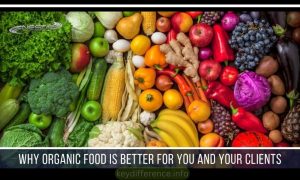
Some studies suggest that organic food may contain higher levels of certain nutrients and antioxidants, contributing to a more nutritious diet and potentially offering health benefits.
The use of genetically modified organisms (GMOs) is absolutely forbidden in the manufacture of organic food. By opting for organic food, you can avoid consuming genetically engineered or modified ingredients, which some individuals prefer to limit due to concerns about their potential long-term effects on human health and the environment. Choosing organic food also aligns with the principles of environmental sustainability. Organic farming methods prioritize the conservation of natural resources, soil fertility, and biodiversity.
By supporting organic agriculture, you contribute to the reduction of chemical pollution, preservation of ecosystems, and promotion of a more sustainable food system. This not only benefits your health but also ensures a healthier planet for future generations.
Lastly, organic farming standards place a strong emphasis on animal welfare. Organic animal products come from animals that have been raised in accordance with strict welfare guidelines, including access to outdoor spaces, pasture, and natural behaviors. By opting for organic animal products, you support farming practices that prioritize the ethical treatment of animals and promote their well-being.
Organic food offers numerous benefits for you and your clients. It reduces exposure to harmful chemicals, provides potentially higher nutrient content, avoids GMOs, supports environmental sustainability, and promotes animal welfare. You may improve your general health, the health of the environment, and the ethical treatment of animals by choosing to eat organic food.
Conclusion
The choice between organic and non-organic food depends on various factors, including personal health goals, budget constraints, environmental concerns, and accessibility. Organic food is produced using natural and sustainable farming practices, without synthetic pesticides, chemical fertilizers, and GMOs.
It offers potential benefits such as reduced exposure to chemicals, potential higher nutrient content, and environmental sustainability. Organic food tends to be more expensive and may have limited availability in some areas.
Non-organic food, on the other hand, is produced using conventional farming methods that may involve the use of synthetic chemicals and GMOs. It is generally more affordable and widely available but may raise concerns about potential pesticide residues, environmental impact, and animal welfare practices.

